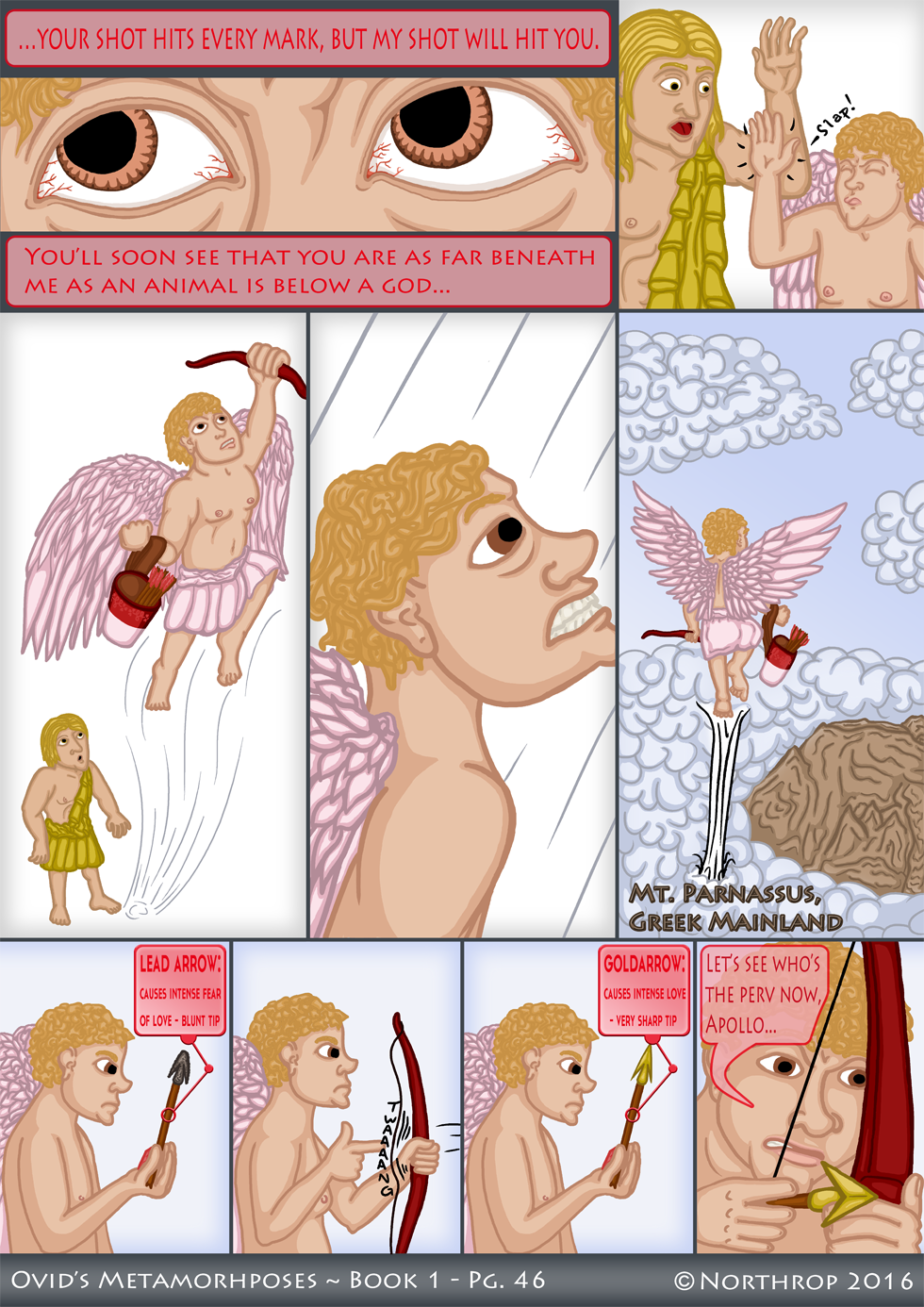Met. 1.466-71 – Cupid’s Vengeful Anger
Dixit et eliso percussis aere pennis
impiger umbrosa Parnasi constitit arce,
eque sagittifera prompsit duo tela pharetra
diversorum operum; fugat hoc, facit illud amorem
(quod facit auratum est et cuspide fulget acuta;
quod fugat obtusum est et habet sub harundine plumbum.)
(Met. 1.466-71)
He spoke, and having split the air on his beating wings,
unwearied he stood on the shadowy summit of Parnassus,
from his arrow-bearing quiver he took out two missiles
each with a different purpose; this one flees [love], that one makes love.
(the one that makes [love] is golden and gleams at its sharp point;
the one that flees is blunt and has lead at the base of its shaft.)
Cupid’s plan begins to unfold, and it’s a rather nasty one. As you can imagine, those two arrows are going into two people. One will be head-over-heels in love, and the other will hate the idea of love. Such a combination can only end in disaster for the two; a disaster on which Cupid is counting. A general rule in classical mythology is that you should never piss off the gods of love. They can cause the worst kinds of trouble for both mortals and immortals. The poor victim of Cupid’s lead arrow (who is Daphne, if you haven’t already guessed) is just an innocent bystander. She is caught in the crossfire of a conflict that reaches so far above her head as to be practically incomprehensible to her. I’ll have more to say on Daphne when she is introduced properly in the next couple of pages. At this point, she is still a distant pawn for Cupid’s machinations.
The arrows of Cupid are actually quite surprising. Less so the golden arrow, which part of a traditional image of Cupid shooting people up and making them fall in love. However, the lead arrow, along with the dichotomy between the two, is very surprising, and might have even been invented by Ovid. Cupid usually causes love – he doesn’t take it away. Logically, though, the lead arrow is sensible; if Cupid has complete dominion over love, then he should be able to take it away as well as give it. Still, this is the first time we see Cupid definitely causing hatred of love. This is not to say that no one in mythology ever hates love. The figure of the anti-sexual hunter or huntress is very common (and usually ends similarly to this story). It seems Ovid has decided to invent a reason for an already common character trope. If you want to know more about the anti-sexual hunters and huntresses, check out Orion by Fontenrose (1981).
Cupid himself is quite powerful, and this scene proves it. Indeed, Cupid has always been seen as powerful. Ovid’s Archaic role-model, Hesiod established this in his famous treatise on the Theogony (“birth of the gods”), one of the oldest Greek poems we have:
ἤτοι μὲν πρώτιστα Χάος γένετ᾿· αὐτὰρ ἔπειτα
Γαῖ᾿ εὐρύστερνος, πάντων ἕδος ἀσφαλὲς αἰεὶ
ἀθανάτων οἳ ἔχουσι κάρη νιφόεντος Ὀλύμπου
Τάρταρά τ᾿ ἠερόεντα μυχῷ χθονὸς εὐρυοδείης,
ἠδ᾿ Ἔρος, ὃς κάλλιστος ἐν ἀθανάτοισι θεοῖσι,
λυσιμελής, πάντων τε θεῶν πάντων τ᾿ ἀνθρώπων
δάμναται ἐν στήθεσσι νόον καὶ ἐπίφρονα βουλήν.
(Hesiod, Theo. 116-22 – text and translation from the Loeb edition by Glenn Most, 2007)
In truth, first of all Chasm [“Chaos”*] came to be, and then
broad-breasted Earth, the ever immovable
seat of all the immortals who possess snowy Olympus’ peak
and murky Tartarus in the depths of the broad-pathed earth,
and Eros, who is the most beautiful among the immortal gods,
the limb-melter—he overpowers the mind and the thoughtful counsel of all the gods and of all human beings
in their breasts.
Here we get the beginning of Hesiod’s cosmogony, and it sounds a lot like a rough outline of the cosmological stories we’ve heard so far in the Metamorphoses. We’ve gotten the story of Chaos and the creation of Earth, even stories of Olympus. This comic and the previous one represent our first encounter with Ovid’s Cupid, however. His Cupid, like Hesiod’s, is so powerful that we can bend the will of mortals and gods. While Cupid/Eros is often depicted as a child (he is more of teenager in Greek art; more infantile in Roman depictions), his image belies his awesome influence over the world. Some ancient schools of philosophy even credited ‘eros’ as the force that keeps things like atoms together. He is in charge of bringing together bodies, both human and figurative. I chose Most’s Loeb, because I very much like his recent paper on Eros, explaining him as the ‘motor’ of genealogical poetics (Most 2013). It seems that Ovid has a similar idea going on here in the Metamorphoses: Cupid’s power and his fickle temperament inaugurate the “erotic” poetics of the Metamorphoses; poetics that will be a staple of the narrative almost up until the very end.
Before signing off, I should note briefly that I went ahead and added dialogue to this page. I normally try to avoid it, but the quip at the end “let’s see who’s the perv now, Apollo”) just made such a nice parallel with Apollo’s taunt on the previous page that I couldn’t resist (“what’re you up to, you little perv?” – which is actually in the poem at line 456).
*Χάος (“chaos”) in Greek translates to a ‘yawning void’ or ‘chasm’. It represents in Hesiod a sense of the nothingness of the universe before creation. Meanwhile, Ovid followed a slightly different tradition that saw Chaos as an amalgamtion of all things.

Discussion ¬